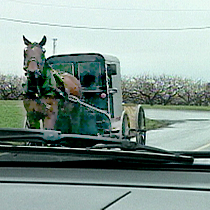-
(单词翻译:双击或拖选)
Lancaster County, Pennsylvania
19 July 2007
Not far from the hustle1 and bustle2 of city life live the Amish of Lancaster County, Pennsylvania. These deeply religious people shun3 the conveniences of modern society to live a simpler life where transportation is a horse and buggy and horsepower really means horsepower. For producer Liu Enming, VOA's Elaine Lu offers a closer look at the Amish of Lancaster County.
 |
| An Amish horse and buggy seen from a passing car |
"They came from Europe, specifically Germany and Switzerland. In 1693 they were a persecuted5 religious group, Because of their persecution6, they were forced to meet in homes, meet in basements, and meet in caves for their church services. So when they came to America, they wanted to keep using their homes as their church buildings."
The Amish are very devout7 and take seriously the biblical commands to separate themselves from the things of the world including electricity. Power comes from propane, kerosene8, wood, coal, or natural gas
 |
| Eric Conner holds an Amish dress |
Conner says, in the Amish community, hats tell men apart from boys. "Here is a teenager's hat. You know he is a teenager by the flatness of the hat and also the ridge12 around the top. This means he is in this what they call the running-around period, meaning they can date, they can choose whether to become an Amish or not. Becoming Amish is voluntary, it's not mandatory13."
As the world around the peaceful farmland changes, so have some of the traditions of the Amish. Lester Hoover, a tour guide at the farm, says transportation is no longer limited to horse-drawn buggies. "There is a division among the Amish over the automobile14. One group got automobiles15, another group kept the horse and buggy. we just simply name them old order -- drive the horse and buggy, and the new order -- drive the automobiles. They have electric, they have meeting houses and they don't have green shades."
But many traditions remain. Amish children attend one-room schoolhouses through grade eight and farming is the mainstay of Amish life. Hoover says there are normally two horses on a farm for buggies. Several mules16 are kept for farming. Milking is one of the most important sources of income on the farm.
Many Amish leaders believe their separation from the outside world strengthens their community. And that community is thriving. Despite what many on the outside would describe as a backwards17 lifestyle, the Amish population in Lancaster County has almost tripled over the past half century.
 收听单词发音
收听单词发音
1
hustle

|
|
| v.推搡;竭力兜售或获取;催促;n.奔忙(碌) | |
参考例句: |
|
|
|
2
bustle

|
|
| v.喧扰地忙乱,匆忙,奔忙;n.忙碌;喧闹 | |
参考例句: |
|
|
|
3
shun

|
|
| vt.避开,回避,避免 | |
参考例句: |
|
|
|
4
marketing

|
|
| n.行销,在市场的买卖,买东西 | |
参考例句: |
|
|
|
5
persecuted

|
|
| (尤指宗教或政治信仰的)迫害(~sb. for sth.)( persecute的过去式和过去分词 ); 烦扰,困扰或骚扰某人 | |
参考例句: |
|
|
|
6
persecution

|
|
| n. 迫害,烦扰 | |
参考例句: |
|
|
|
7
devout

|
|
| adj.虔诚的,虔敬的,衷心的 (n.devoutness) | |
参考例句: |
|
|
|
8
kerosene

|
|
| n.(kerosine)煤油,火油 | |
参考例句: |
|
|
|
9
cape

|
|
| n.海角,岬;披肩,短披风 | |
参考例句: |
|
|
|
10
apron

|
|
| n.围裙;工作裙 | |
参考例句: |
|
|
|
11
coffin

|
|
| n.棺材,灵柩 | |
参考例句: |
|
|
|
12
ridge

|
|
| n.山脊;鼻梁;分水岭 | |
参考例句: |
|
|
|
13
mandatory

|
|
| adj.命令的;强制的;义务的;n.受托者 | |
参考例句: |
|
|
|
14
automobile

|
|
| n.汽车,机动车 | |
参考例句: |
|
|
|
15
automobiles

|
|
| n.汽车( automobile的名词复数 ) | |
参考例句: |
|
|
|
16
mules

|
|
| 骡( mule的名词复数 ); 拖鞋; 顽固的人; 越境运毒者 | |
参考例句: |
|
|
|
17
backwards

|
|
| adv.往回地,向原处,倒,相反,前后倒置地 | |
参考例句: |
|
|
|















